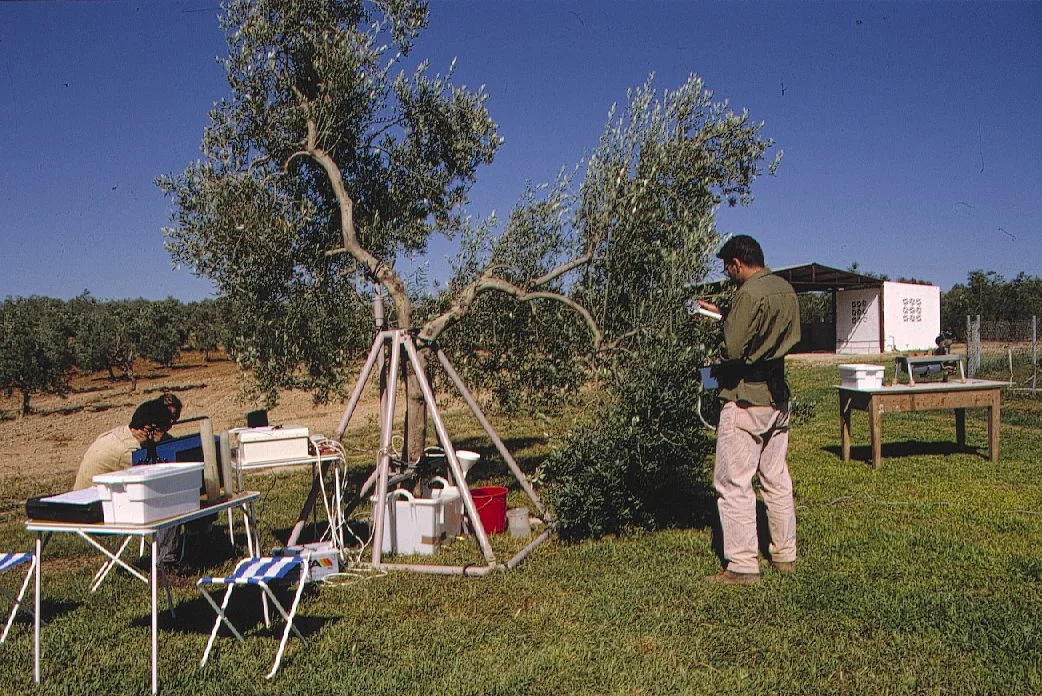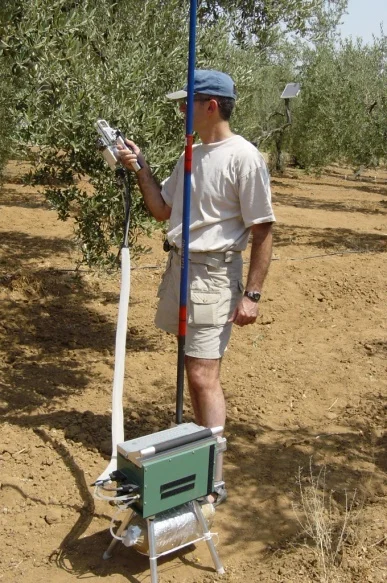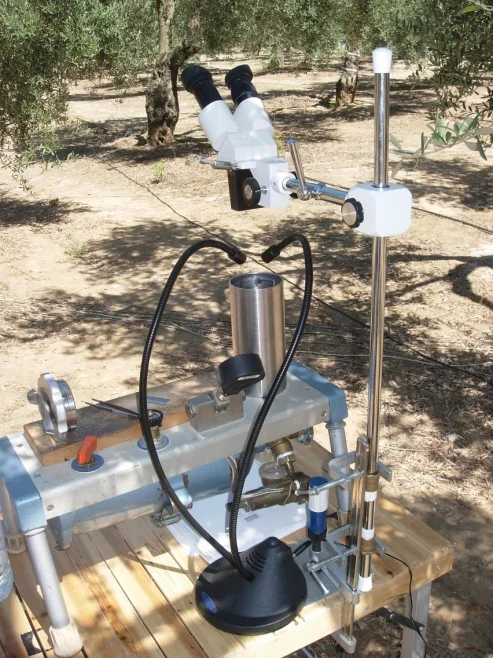Grupo
Ecofisiología Vegetal y Riego
ECOVER
Descripción
En el grupo de investigación ECOVER nos dedicamos a estudiar procesos fisiológicos asociados con la respuesta de las plantas al déficit hídrico, desde los relacionados con el crecimiento y producción a los implicados en la mortalidad de las plantas. Tras el análisis de dichos procesos evaluamos su aplicación a sistemas agronómicos y forestales. El conocimiento generado, combinado con el uso de modelos para su integración y la aplicación de tecnologías para el seguimiento continuo de variables, nos permite abordar cuestiones específicas relacionadas con la optimización del riego, el crecimiento y desarrollo, la identificación de especies y variedades resistentes a la sequía, y con procesos de decaimiento y mortalidad.
Nuestro grupo ECOVER está compuesto por 9 doctores, 1 técnico y un número variable de investigadores predoctorales, además de personas contratadas de diverso tipo y personas que hacen su TFM o TFG. Mantenemos colaboraciones nacionales e internacionales con grupos de investigación, universidades, centros de investigación, divulgación y transferencia, y empresas del sector.
Objetivos
Entender la respuesta de las plantas al déficit hídrico e identificar los mecanismos implicados, nos permite abordar una amplia variedad de objetivos. Desde una perspectiva agronómica, desarrollamos y mejoramos estrategias de riego para optimizar el uso del agua en la agricultura, así como indicadores de estrés hídrico y sistemas de apoyo a la toma de decisiones para la programación del riego. Desde un enfoque forestal, identificamos los rasgos y procesos fisiológicos que son cruciales para el crecimiento y la supervivencia de las plantas en condiciones de escasez de agua. Los resultados obtenidos nos permiten implementar modelos que integran estos procesos fisiológicos y mejorar la interpretación de los sensores instalados en las plantas, lo que facilita el estudio de su respuesta ante diversos escenarios de cambio climático.
Nuestras líneas principales de trabajo son:
- Regulación del intercambio gaseoso en respuesta a déficit hídrico en el suelo y en la atmósfera (Antonio Díaz Espejo y Celia M. Rodríguez Domínguez).
Estudiamos los mecanismos de regulación de la conductancia estomática que determina en gran medida los flujos de agua y carbono en las hojas, y que se manifiestan en la primera fase de respuesta al déficit hídrico. Comprender la regulación del intercambio gaseoso exige la integración de la capacidad hidráulica y fotosintética, los parámetros que definen las relaciones hídricas y el papel de las fitohormonas, como el ABA. Esto nos lleva a estudiar qué componentes del sistema hidráulico tienen un papel más relevante en la regulación de la apertura estomática, teniendo en cuenta no sólo las relativas a la planta sino también a las interfases suelo-raíz y hoja-atmósfera. Nuestro enfoque nos ayuda a comprender, por ejemplo, el impacto del uso del riego deficitario y localizado en la producción de las plantas, así como las diferencias entre cultivos y variedades, y contribuye a explicar fenómenos de crecimiento, competencia, adaptación y aclimatación de las plantas.
- Análisis de las limitaciones principales del crecimiento vegetal: turgencia y fotosíntesis (Virginia Hernández Santana)
Utilizamos sensores y modelos mecanísticos para discernir la importancia relativa de los factores que limitan el crecimiento vegetal en condiciones de déficit hídrico. Comparamos la importancia de la fotosíntesis con la turgencia. Desarrollamos métodos novedosos para medir de forma automática y sencilla fotosíntesis y turgencia. Analizamos cómo los rasgos fisiológicos y anatómicos de las distintas especies determinan su funcionamiento bajo condiciones de déficit hídrico en relación a los flujos de carbono y agua.
- Funcionalidad hidráulica y mecanismos de resistencia y supervivencia al déficit hídrico (José Manuel Torres Ruiz)
Estudiamos las respuestas de las plantas a condiciones que provocan estrés hídrico, tanto en especies de relevancia forestal como en aquellas de interés agronómico. Nuestro enfoque se centra especialmente en comprender las variaciones en la funcionalidad hidráulica, en particular sobre el riesgo de cavitación, así como en analizar los procesos fisiológicos ligados al decaimiento y la mortalidad asociados a la escasez de agua. Trabajamos en la caracterización y descripción de los rasgos fisiológicos más relevantes para la supervivencia vegetal y que determinan la evolución temporal de procesos como la tasa de cavitación o el riesgo de fallo hidráulico. Los resultados de nuestros estudios nos permiten evaluar de manera precisa el impacto del cambio climático en la dinámica y comportamiento tanto de los cultivos como de la vegetación en diversos ecosistemas.
- Riego deficitario y de precisión en fincas digitalizadas (José Enrique Fernández)
Elaboramos estrategias de riego deficitario que permiten el desarrollo de una agricultura intensiva sostenible. Desarrollamos indicadores de estrés hídrico para su aplicación en la programación del riego de fincas digitalizadas, aptos para un riego de precisión. Trabajamos con indicadores convencionales (potencial hídrico y conductancia estomática) y automáticos (flujo de savia, variación del diámetro del tronco, presión de turgencia de la hoja). Desarrollamos algoritmos para la interpretación de la información necesaria para la programación del riego y el desarrollo de aplicaciones para la transmisión sencilla y efectiva de la información al agricultor. Esto incluye el desarrollo de sistemas para la ayuda a la toma de decisiones, IoT, inteligencia artificial, aplicaciones para el teléfono móvil y otras técnicas relacionadas con la digitalización del uso del agua en una agricultura digitalizada.
Componentes

José Enrique Fernández Luque
Profesor de Investigación del CSIC
Doctor Ingeniero Agrónomo
Responsable del grupo
Director del IRNAS
jefer[AT]irnase.csic.es

Rafael Romero Vicente
Titulado Superior de Actividades Técnicas y Profesionales
Doctor en Ingeniería de Sistemas y Automática
rafaelromero[AT]irnas.csic.es

Antonio Montero de Espinosa Marín
Titulado medio de Actividades Técnicas y Profesionales
Ing.Tec. Agricola
amontero[AT]irnase.csic.es


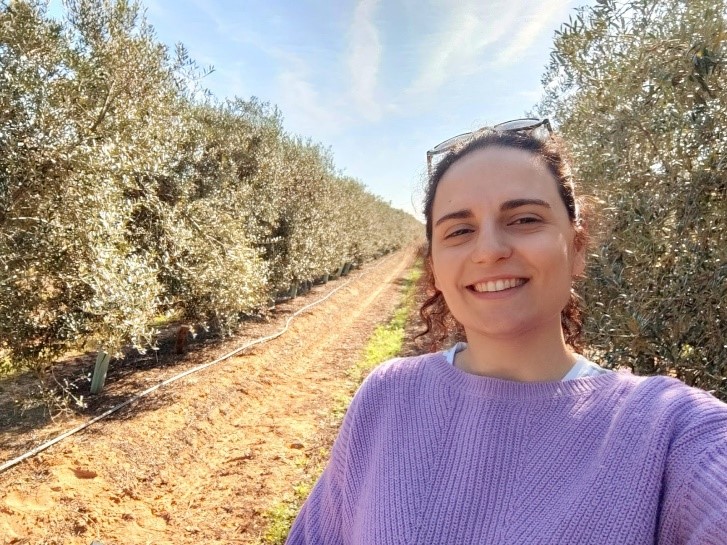
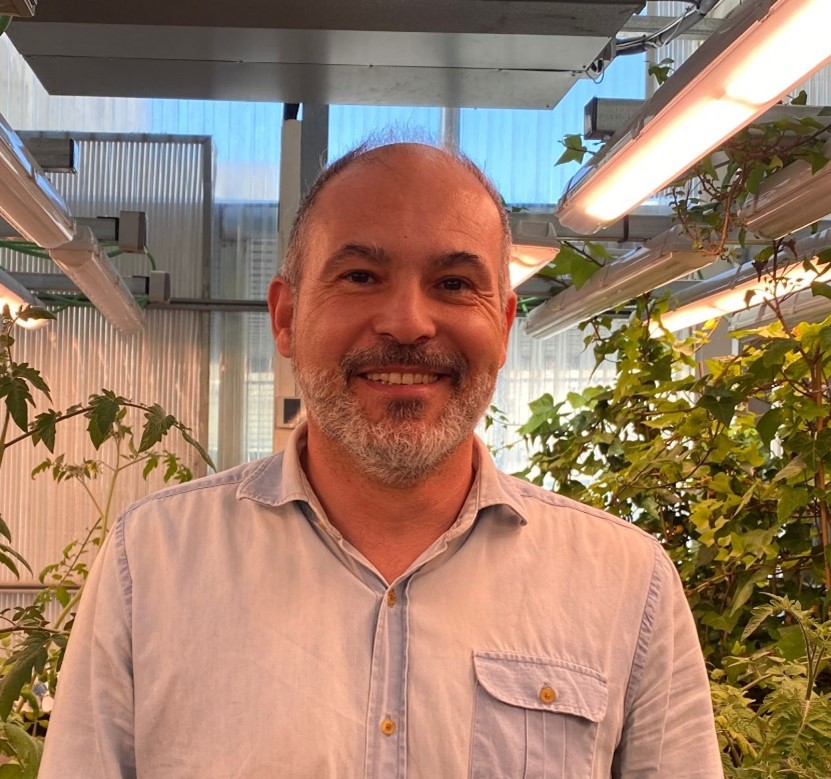

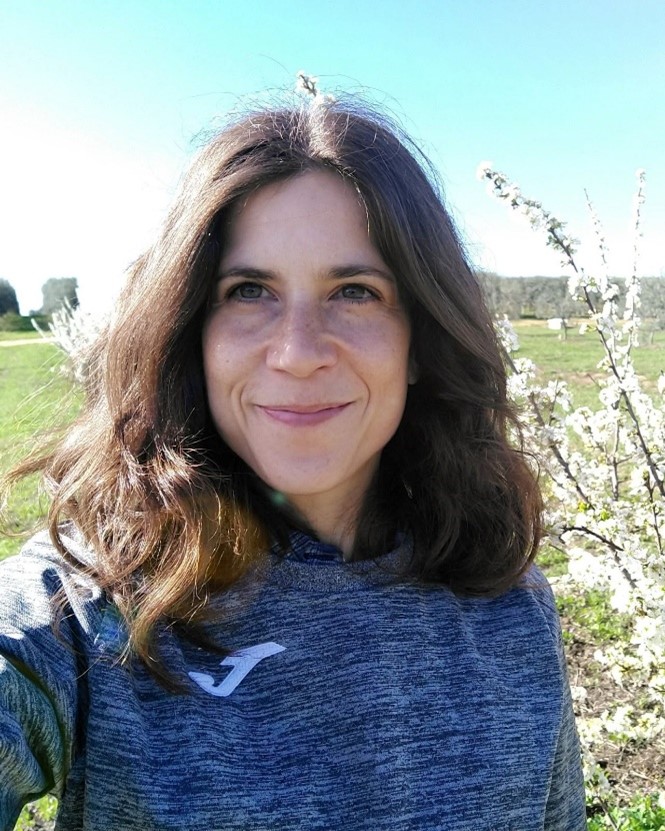
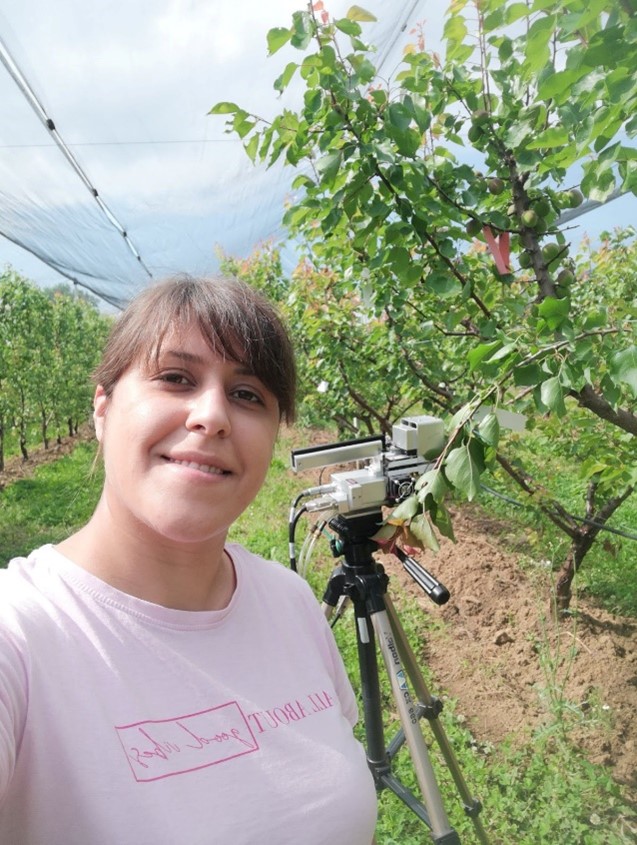
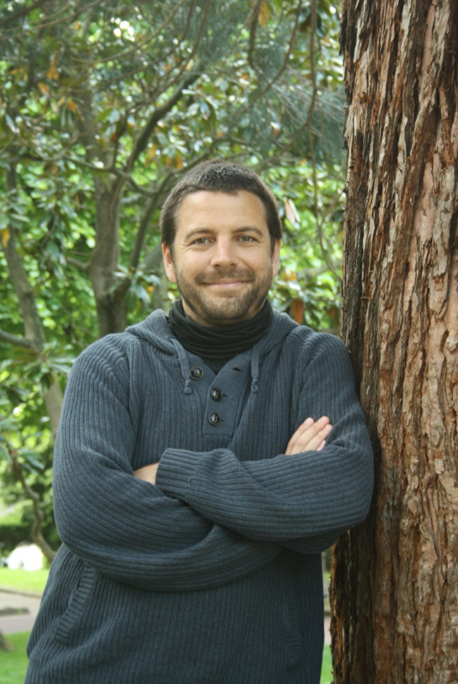
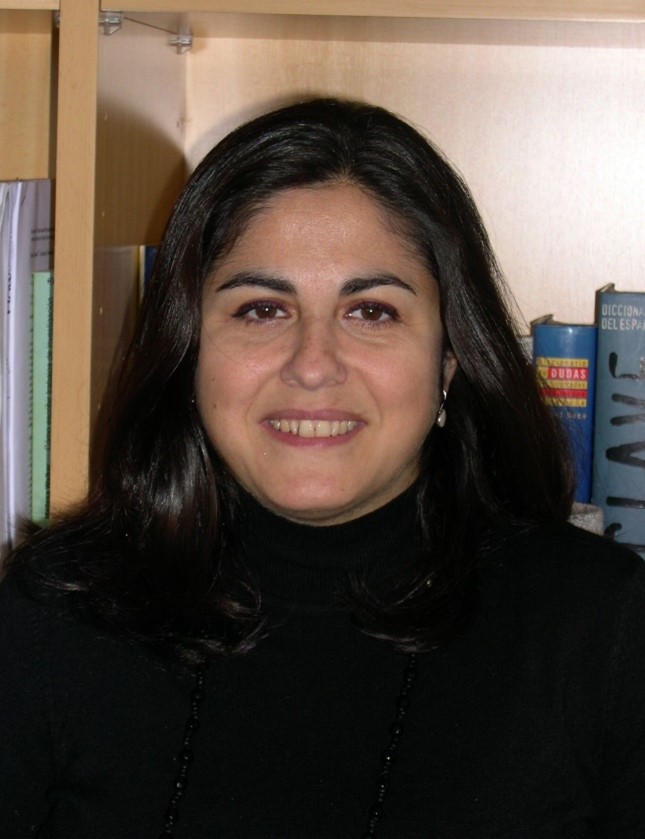
María Victoria Cuevas Sánchez
Titulada Superior de Actividades Técnicas y Profesionales
Doctora en Biología
mvcuevas[AT]irnase.csic.es


Jaime Sebastian Azcona
Investigador postdoctoral
Doctor en ecología y manejo forestal
jsebastian[AT]irnas.csic.es
Enlaces de interés sobre la actividad del grupo
Video presentación del grupo REC.
Presentación del Servicio de Ecofisiología vegetal
Reportaje programa “Tierra y Mar” de Canal Sur (26/11/2023)
https://www.canalsurmas.es/videos/99314-espacio-protegido-septiembre-diciembre-2023-05112023/
Reportaje programa “Espacio Protegido” de Canal Sur (05/11/2023)
https://www.canalsurmas.es/videos/106839-tierra-y-mar-septiembre-diciembre-2023-26112023/
Reportaje programa #EnRed de Canal Sur para explicar Proyecto Watchplant
Reportaje en el programa Tierra y Mar de Canal Sur. “El riego inteligente para conseguir cultivos más eficaces”. Audiodescrito e interpretado en LSE.
Vídeo sobre la actividad del grupo en el Proyecto Recupera 2020. Se explican técnicas para la programación del riego.
Reportaje en “Cuaderno Agrario”, programa 199, titulado Finaliza el proyecto CIT del Grupo de Innovación liderado por ASAJA-Sevilla, sobre el uso de una cámara termográfica para el riego de precisión. Publicado el 8 de junio de 2020. (Ir a minuto 29.30)
Información que el grupo desarrolló para el Grupo de Trabajo sobre Flujo de Savia de la International Society of Horticultural Sciences, del cual el Dr. Fernández fue Chair entre 2008 y 2017.
www.ishs.org/sap-flow/ishs-working-group-sap-flow-online-resources
Publicaciones
Torres-Ruiz JM, Cochard H, Delzon S, Boivin T, Burlett R, Cailleret M, Corso D, Delmas CEL, De Caceres M, Diaz-Espejo A, Fernández-Conradi P, Guillemot J, Lamarque LJ, Limousin JM, Mantova M, Mencuccini M, Morin X, Pimont F, Resco De Dios V, Ruffault J, Trueba S & Martin-StPaul NK. 2024. Plant hydraulics at the heart of plant, crops and ecosystem functions in the face of climate change. New Phytologist – Tansley Review 241, 984-999. https://doi.org/10.1111/nph.19463.
Pichaco, J., Manandhar, A., & McAdam, S. A. M. (2024). Mechanical advantage makes stomatal opening speed a function of evaporative demand. Plant Physiology, 1–8. https://doi.org/10.1093/plphys/kiae023
Marta Lucas, Diaz-Espejo A, David Romero-Jimeneza, Procopio Peinado-Torrubia, Alba Delgado-Vaquero, Rosario Álvarez, José M. Colmenero-Floresa, Miguel A. Rosales. 2023. Chloride reduces plant nitrate requirement and alleviates low nitrogen stress symptoms. Plant Physiology and Biochemistry, 212; https://doi.org/10.1016/j.plaphy.2024.108717
De la Rosa JM, Campos P, Diaz-Espejo A. 2022. Soil Biochar Application: Assessment of the Effects on Soil Water Properties, Plant Physiological Status, and Yield of Super-Intensive Olive Groves under Controlled Irrigation Conditions. Agronomy 2022, 12(10), 2321; https://doi.org/10.3390/agronomy12102321
Fernández, J.E. 2023. Editorial note on terms for crop evapotranspiration, water use efficiency and water productivity. Agricultural Water Management 289, 108548.
Gutiérrez-Gordillo, S., Pérez-González, J.M., Sancho-Galán, P., Amores-Arrocha, A., Palacios, V., Jiménez-Cantizano, A. Physiological, Enological and Agronomic Characterization of Pedro Ximénez Grapevine Cultivar under Organic Farming in a Warm Climate Zone. Agronomy 2023, 13, 1732. https://doi.org/10.3390/agronomy13071732
Gutiérrez-Gordillo, S., García-Tejero, I.F., Durán Zuazo, V.H., Diaz-Espejo, A., Hernandez-Santana, V. The effect of nut growth limitation on triose phosphate utilization and downregulation of photosynthesis in almond, Tree Physiology, Volume 43, Issue 2, February 2023, Pages 288–300, https://doi.org/10.1093/treephys/tpac122
Mantova M., Cochard H., Burlett R., Delzon S., King A., Rodriguez‐Dominguez C.M., … Torres‐Ruiz J.M. (2023) On the path from xylem hydraulic failure to downstream cell death. New Phytologist 237, 793–806. https://onlinelibrary.wiley.com/doi/10.1111/nph.18578
Hernandez-Santana V., Rodriguez-Dominguez C.M., Sebastian-Azcona J., Perez-Romero L.F. & Diaz-Espejo A. (2023) Role of hydraulic traits in stomatal regulation of transpiration under different vapour pressure deficits across five Mediterranean tree crops. Journal of Experimental Botany 74, 4597–4612. https://academic.oup.com/jxb/article/74/15/4597/7146537
Liu J., Li D., Fernández J.E., Coleman M, Hu W., Di N., Zou S., Liu Y., Xi B., Clothier B. 2022. Variations in water-balance components and carbon stocks in poplar plantations with differing water inputs over a whole rotation: implications for sustainable forest management under climate change. Agricultural and Forest Meteorology, 320, 108958.
Giovannini, A., Venturi, M., Gutiérrez-Gordillo, S., Manfrini, L., Corelli-Grappadelli, L., Morandi, B. Vascular and Transpiration Flows Affecting Apricot (Prunus armeniaca L.) Fruit Growth. Agronomy 2022, 12, 989. https://doi.org/10.3390/agronomy12050989
Rodriguez‐Dominguez C.M., Forner A., Martorell S., Choat B., Lopez R., Peters J.M.R., … Sack L. (2022) Leaf water potential measurements using the pressure chamber: Synthetic testing of assumptions towards best practices for precision and accuracy. Plant, Cell & Environment 45, 2037–2061. https://onlinelibrary.wiley.com/doi/10.1111/pce.14330
Gauthey A., Peters J.M.R., Lòpez R., Carins‐Murphy M.R., Rodriguez‐Dominguez C.M., Tissue D.T., … Choat B. (2022) Mechanisms of xylem hydraulic recovery after drought in Eucalyptus saligna . Plant, Cell & Environment, 1–13. https://onlinelibrary.wiley.com/doi/10.1111/pce.14265
Duddek P., Carminati A., Koebernick N., Ohmann L., Lovric G., Delzon S., Rodriguez-Dominguez C.M., King A., Ahmed M.A. (2022) The impact of drought-induced root and root hair shrinkage on root–soil contact. Plant Physiology 189, 1232–1236. https://academic.oup.com/plphys/article/189/3/1232/6553680
B., Xi, Clothier, B., Duan. J., Coleman, M., Hu, W., Li, D-. Di, N., Liu, Y., Fu, J., Li, J., Jia, L., Fernández, J.E. 2021. Irrigation management in poplar plantations: A review. Forest Ecology and Management 494 (2021) 119330
Fernandes R. D. M., Egea G., Hernandez-Santana V., Diaz-Espejo A., Fernández J.E., Perez-Martin A., Cuevas M.V. 2021. Response of vegetative and fruit growth to the soil volume wetted by irrigation in a super-high-density olive orchard. Agricultural Water Management, 258, 107197.
Gutiérrez-Gordillo, S., de la Gala González-Santiago, J., Trigo-Córdoba, E., Rubio-Casal, A.E., García-Tejero, I.F., Egea, G. Monitoring of Emerging Water Stress Situations by Thermal and Vegetation Indices in Different Almond Cultivars. Agronomy 2021, 11, 1419. https://doi.org/10.3390/agronomy11071419
Brodribb T., Brodersen C.R., Carriqui M., Tonet V., Rodriguez Dominguez C. & McAdam S. (2021) Linking xylem network failure with leaf tissue death. New Phytologist 232, 68–79. https://onlinelibrary.wiley.com/doi/10.1111/nph.17577
Li, D., Fernández, J.E., Li X., Xi, B., Jia, L., Hernandez-Santana, V., 2020. Tree growth patterns and diagnosis of water status based on trunk diameter fluctuations in fast-growing Populus tomentosa plantations. Agricultural Water Management 241, 106348
J.E. Fernández, F. Alcon, A. Diaz-Espejo, V. Hernandez-Santana, M.V. Cuevas. 2020. Water use indicators and economic analysis for on-farm irrigation decision: A case study of a super high density olive tree orchard. Agricultural Water Management 237, 106074.
J.E. Fernández, A. Diaz-Espejo, J.M. Martínez-Rivas, W. Moreda. 2020. Editorial: Proceedings of the Olivebioteq 2018 – Olive Management, Biotechnology and Authenticity of Olive Products. Frontiers in Plant Science, Vol. 11, Article 860. 3 pp. doi: 10.3389/fpls.2020.00860
C.M. Rodriguez-Dominguez & T.J. Brodribb, 2020. Declining root water transport drives stomatal closure in olive under moderate water stress. New Phytologist, 225: 126 – 134.
Gauthey, J.M.R. Peters, M.R. Carins-Murphy, C.M. Rodriguez-Dominguez, X. Li, S. Delzon, A. King, R. López, B.E. Medlyn, D.T. Tissue, T.J. Brodribb & B. Choat., 2020. Visual and hydraulic techniques produce similar estimates of cavitation resistance in woody species. New Phytologist, 228: 884 – 897.
Gutiérrez-Gordillo, S.; García-Tejero, I. F.; Durán Zuazo, V.H.; García Escalera, A.; Ferrera Gil, F.; Amores-Agüera, J.; Cárceles Rodríguez, B.; Hernández-Santana, V., 2020. Assessing the Water-Stress Baselines by Thermal Imaging for Irrigation Management in Almond Plantations under Water Scarcity Conditions. Water 12 (5): 1298.
Gutiérrez-Gordillo, S.; Durán Zuazo, V.H.; Hernández-Santana, V.; Ferrera Gil, F.; García Escalera, A.; Amores-Agüera, J.J.; García-Tejero, I.F., 2020. Cultivar Dependent Impact on Yield and Its Components of Young Almond Trees under Sustained-Deficit Irrigation in Semi-Arid Environments. Agronomy, 10, 733.
Sinacore, K., Asbjornsen, H., Hernandez-Santana, V., Hall, J.S., 2020. Differential and dynamic water regulation responses to El Niño for monospecific and mixed species planted forests. Ecohydrology 13, e2238.
Hernandez-Santana, P. Diaz-Rueda, A. Diaz-Espejo, M.D. Raya-Sereno, S. Gutiérrez-Gordillo, A. Montero, A. Perez-Martin, J.M. Colmenero-Flores & C.M. Rodriguez-Dominguez., 2019. Hydraulic traits emerge as relevant determinants of growth patterns in wild olive genotypes under water stress. Frontiers in Plant Science, 10: 1 – 15.
Rodriguez Dominguez, C.M., Hernandez-Santana, V., Buckley T.N., Fernández, J.E., Diaz-Espejo, A. 2019. Sensitivity of olive leaf turgor to air vapour pressure deficit correlates with diurnal maximum stomatal conductance. Agricultural and Forest Meteorology, 272-273, 156-165.
T.J. Brodribb, H. Cochard & C.M. Rodriguez-Dominguez., 2019. Measuring the pulse of trees; using the vascular system to predict tree mortality in the 21st century. Conservation Physiology, 7: 1 – 7.
Sinacore, K., Asbjornsen, H., Hernandez-Santana, V., Hall, J.S. 2019. Drought differentially affects growth, transpiration, and water use efficiency of mixed and monospecific planted forests. Forests, 10, 153
C.M. Rodriguez-Dominguez, M.R. Carins Murphy, C. Lucani & T.J. Brodribb., 2018. Mapping xylem failure in disparate organs of whole plants reveals extreme resistance in olive roots. New Phytologist, 218: 1025 – 1035.
Ferreira, I.M., Green, S.R., Conceinçao. N., J.E. Fernández. 2018. Assessing hydraulic redistribution with the compensated average gradient heat-pulse method on rain-fed olive trees. Plant and Soil, 425:21–4.
C.M. Padilla-Díaz, C.M. Rodriguez-Dominguez, V. Hernandez-Santana, A. Perez-Martin, R.D.M. Fernandes, A. Montero, J.M. García, J.E. Fernández. 2018. Water status, gas exchange and crop performance in a super high density olive orchard under deficit irrigation scheduled from leaf turgor measurements. Agricultural Water Management 202: 241-252.
Hernandez-Santana, V., Fernandes, R.D.M., Perez-Arcoiza, A., Fernández, J.E., Garcia, J.M, Diaz-Espejo, A. 2018. Relationships between fruit growth and oil accumulation with simulated seasonal dynamics of leaf gas exchange in the olive tree. Agricultural and Forest Meteorology 256-257: 458-469. https://doi.org/10.1016/j.agrformet.2018.03.019
Hernández, M.L., Velázquez-Palmero, D., Sicardo, M.D., Fernández, J.E., Diaz-Espejo, A., Martínez-Rivas, J.M. 2018. Effect of a regulated deficit irrigation strategy in a hedgerow ‘Arbequina’ olive orchard on the mesocarp fatty acid composition and desaturase gene expression with respect to olive oil quality. Agricultural Water Management, 204 (2018) 100-106.
Fernandes, R.D.M., Cuevas, M.V., Diaz-Espejo, A., Hernandez-Santana, V. 2018. Effects of water stress on fruit growth and water relations between fruits and leaves in a hedgerow olive orchard. Agricultural and Water Management, 210, 32-40
García, J.M., Morales-Sillero, A., Pérez-Rubio, A.G., Diaz-Espejo, A., Montero, A., Fernández, J.E. 2017. Virgin olive oil quality of hedgerow ‘Arbequina’ olive trees under deficit irrigation. Journal of the Science of Food and Agriculture. 2017, 97(3):1018-1026
Egea, G.; Padilla-Díaz, C.M.; Martinez-Guanter, J.; Fernández, J.E.; Pérez-Ruiz, M. 2017.
Assessing a crop water stress index derived from aerial thermal imaging and infrared thermometry in super-high density olive orchards
Agricultural Water Management; vol: 187 ; Páginas: 210 – 221
García-Tejero, I.F.; Hernández, A.; Padilla-Díaz, C.M.; Diaz-Espejo, A.; Fernández, J.E. 2017.
Assessing plant water status in a hedgerow olive orchard from thermography at plant level
Agricultural Water Management; vol: 188 ; Páginas: 50 – 60
Fernandes, R.D.M.; Cuevas, M.V.; Hernandez-Santana, V.; Rodriguez-Dominguez, C.M.; Padilla-Díaz, C.M.; Fernández, J.E. 2017.
Classification models for automatic identification of daily states from leaf turgor related measurements in olive
Computers and Electronics in Agriculture; vol: 142 ; Páginas: 181 – 189
Eduardo Fernández-Pascual; Adrián Pérez-Arcoiza; José Alberto Prieto; Tomás E. Díaz 2017.
Environmental filtering drives the shape and breadth of the seed germination niche in coastal plant communities
Annals of Botany; vol: 119 ; Páginas: 1169 – 1177
Egea G.; Fernández J.E.; Alcon F. 2017.
Financial assessment of adopting irrigation technology for plant-based regulated deficit irrigation scheduling in super high-density olive orchards
Agricultural Water Management; vol: 187 ; Páginas: 47 – 56
Hernandez-Santana, V.; Fernández, J.E.; Cuevas, M.V.; Perez-Martin, A.; Diaz-Espejo, A. 2017.
Photosynthetic limitations by water deficit: Effect on fruit and olive oil yield, leaf area and trunk diameter and its potential use to control vegetative growth of super-high density olive orchards
Agricultural Water Management; vol: 184 ; Páginas: 9 – 18
Torres-Ruiz, J.M.; Cochard, H.; Choat, B.; Jansen, S.; López, R.; Tomášková, I.; Padilla-Díaz, C.M.; Badel, E.; Burlett, R.; King, A.; Lenoir, N.; Martin-StPaul, N.K.; Delzon, S. 2017.
Xylem resistance to embolism: presenting a simple diagnostic test for the open vessel artefact
New Phytologist; vol: 215 ; Páginas: 489 – 499
Fernández-Boyano, M.; Tabernero- Pérez, D.; Alonso-Herrero, S.; Pérez-Álvarez, J.M.; Blanco-Velázquez, F.J.; Anaya-Romero, M.; Fernández-Luque, J.E. 2016.
Developing the prototype AndaLAND for agriculture soil and water assessment in climate change scenarios
Spanish Journal of Soil Science; vol: 6 ; Páginas: 21 – 25
Molina, A.J.; Aranda, X.; Carta, G.; Llorens, P.; Romero, R.; Savé, R.; Biel, C. 2016.
Effect of irrigation on sap flux density variability and water use estimate in cherry (Prunus avium) for timber production: Azimuthal profile, radial profile and sapwood estimation
Agricultural Water Management; vol: 164 ; Páginas: 118 – 126
Koenig, W.D.; Alejano, R.; Carbonero, M.D.; Fernández-Rebollo, P.; Knops, J.M.H.; Marañón, T.; Padilla-Díaz, C.M.; Pearse, I.S.; Pérez-Ramos, I.M.; Vázquez-Piqué, J.; Pesendorfer, M.B. 2016.
Is the relationship between mast-seeding and weather in oaks related to their life-history or phylogeny?
Ecology; vol: 97 ; Páginas: 2603 – 2615
Peguero-Pina JJ; Sisó S; Sancho-Knapik D; Diaz-Espejo A; Flexas J; Galmés J; Gil-Pelegrín E. 2016.
Leaf morphological and physiological adaptations of a deciduous oak (Quercus faginea Lam.) to the Mediterranean climate: a comparison with a closely related temperate species (Quercus robur L.)
Tree Physiology; vol: 36 ; Páginas: 287 – 299
Flexas, J; Diaz-Espejo, A; Conesa, M; Coopman, R; Douthe, C; Gago, J; Gallé, A; Galmes, J; Medrano, H; Ribas-Carbo, M; Tomás, M; Niinemets, Ü. 2016.
Mesophyll conductance to CO2 and Rubisco as targets for improving intrinsic water use efficiency in C3 plants.
Plant, Cell and Environment; vol: 39 ; Páginas: 965 – 982
Rodriguez-Dominguez, C.M.; Buckley, T.N.; Egea, G.; de Cires, A.; Hernandez-Santana, V.; Martorell, S.; Diaz-Espejo, A. 2016.
Most stomatal closure in woody species under moderate drought can be explained by stomatal responses to leaf turgor
Plant, Cell and Environment; vol: 39 ; Páginas: 2014 – 2026
Hernandez-Santana, Virginia; Rodriguez-Dominguez, Celia M.; Fernández, J. Enrique; Diaz-Espejo, Antonio 2016.
Role of leaf hydraulic conductance in the regulation of stomatal conductance in almond and olive in response to water stress
Tree Physiology; vol: 26 ; Páginas: 725 – 735
Padilla-Díaz C.M.; Rodriguez-Dominguez C.M.; Hernandez-Santana V.; Perez-Martin A.; Fernández J.E. 2016.
Scheduling regulated deficit irrigation in a hedgerow olive orchard from leaf turgor pressure related measurements
Agricultural Water Management; vol: 164 ; Páginas: 28 – 37
Egea G.; Diaz-Espejo A.; Fernández J.E. 2016.
Soil moisture dynamics in a hedgerow olive orchard under well-watered and deficit irrigation regimes: assessment, prediction and scenario analysis.
Agricultural Water Management; vol: 164 ; Páginas: 197 – 211
V. Hernandez-Santana; J.E. Fernández; C.M. Rodriguez-Dominguez; R. Romero; A. Diaz-Espejo 2016.
The dynamics of radial sap flux density reflects changes in stomatal conductance in response to soil and air water deficit.
Agricultural and Forest Meteorology; vol: 218-219 ; Páginas: 92 – 101
Naranjo B; Diaz-Espejo A; Lindahl M; Cejudo FJ 2016.
Type-f thioredoxins have a role in the short-term activation of carbon metabolism and their loss affects growth under short-day conditions in Arabidopsis thaliana.
Journal of Experimental Botany; vol: 67 ; Páginas: 1951 – 1964
García, J.M.; Morales-Sillero, A.; Pérez-Rubio, A.G.; Diaz-Espejo, A.; Montero, A.; Fernández, J.E. 2016.
Virgin olive oil quality of hedgerow Arbequina olive trees under deficit irrigation
Journal of the Science of Food and Agriculture; vol: 97 ; Páginas: 1018 – 1026
Salmon, Y.; Torres-Ruiz, J.M.; Poyatos, R.; Martinez-Vilalta, J.; Meir, P.; Cochard, H.; Mencuccini, M. 2015.
Balancing the risks of hydraulic failure and carbon starvation: A twig scale analysis in declining Scots pine
Plant, Cell and Environment; vol: 38 ; Páginas: 2575 – 2588
Mateos-Naranjo, E.; Mesa, J.; Pajuelo, E.; Perez-Martin, A.; Caviedes, M.A.; Rodríguez-Llorente, I.D. 2015.
Deciphering the role of plant growth-promoting rhizobacteria in the tolerance of the invasive cordgrass Spartina densiflora to physicochemical properties of salt-marsh soils
Plant and Soil; vol: 394 ; Páginas: 45 – 55
Martorell, S.; Diaz-Espejo, A.; Tomàs, M.; Pou, A.; El Aou-ouad, H.; Escalona, J.M.; Vadell, J.; Ribas-Carbó, M.; Flexas, J.; Medrano, H. 2015.
Differences in water-use-efficiency between two Vitis vinifera cultivars (Grenache and Tempranillo) explained by the combined response of stomata to hydraulic and chemical signals during water stress
Agricultural Water Management; vol: 156 ; Páginas: 1 – 9
Elsayed-Farag, S.; Melgar, J.C. 2015.
Efficiency of tree-based water status indicators at the onset of water deficit in citrus
Horticulture Environment and Biotechnology; vol: 56 ; Páginas: 305 – 309
Pérez-Ramos, I. M.; Padilla-Díaz, C.M.; Koenig, W. D.; Marañón, T. 2015.
Environmental drivers of mast-seeding in Mediterranean oak species: does leaf habit matter?
Journal of Ecology; vol: 103 ; Páginas: 691 – 700
Girón, I.F.; Corell, M.; Martín-Palomo, M.J.; Galindo, A.; Torrecillas, A.; Moreno, F.; Moriana, A. 2015.
Feasibility of trunk diameter fluctuations in the scheduling of regulated deficit irrigation for table olive trees without reference trees
Agricultural Water Management; vol: 161 ; Páginas: 114 – 126
Flexas, J.; Diaz-Espejo, A. 2015.
Interspecific differences in temperature response of mesophyll conductance: Food for thought on its origin and regulation
Plant, Cell and Environment; vol: 38 ; Páginas: 625 – 628
Buckley, T.N.; Diaz-Espejo, A. 2015.
Partitioning changes in photosynthetic rate into contributions from different variables
Plant, Cell and Environment; vol: 38 ; Páginas: 1200 – 1211
Martorell, S.; Medrano, H.; Tomàs, M.; Escalona, J.M.; Flexas, J.; Diaz-Espejo, A. 2015.
Plasticity of vulnerability to leaf hydraulic dysfunction during acclimation to drought in grapevines: An osmotic-mediated process
Physiologia Plantarum; vol: 153 ; Páginas: 381 – 391
Torres-Ruiz, J.M.; Diaz-Espejo, A.; Perez-Martin, A.; Hernandez-Santana, V. 2015.
Role of hydraulic and chemical signals in leaves, stems and roots in the stomatal behaviour of olive trees under water stress and recovery conditions
Tree Physiology; vol: 35 ; Páginas: 415 – 424
Hernandez-Santana, V.; Hernandez-Hernandez, A.; Vadeboncoeur, M.A.; Asbjornsen, H. 2015.
Scaling from single-point sap velocity measurements to stand transpiration in a multispecies deciduous forest: Uncertainty sources, stand structure effect, and future scenarios
Canadian Journal of Forest Research; vol: 45 ; Páginas: 1489 – 1497
Thomas N. Buckley; Sebastia Martorell; Antonio Diaz-Espejo; Magdalena Tomàs; Hipólito Medrano 2014.
Is stomatal conductance optimized over both time and space in plant crowns? A field test in grapevine (Vitis vinifera)
Plant, Cell and Environment; vol: 37 ; Páginas: 2707 – 2721
Flexas, J.; Diaz-Espejo, A.; Gago, J.; Gallé, A.; Galmés, J.; Gulías, J.; Medrano, H. 2014.
Photosynthetic limitations in Mediterranean plants: A review
Environmental and Experimental Botany; vol: 103 ; Páginas: 12 – 23
Fernández, J.E. 2014.
Plant-based sensing to monitor water stress: Applicability to commercial orchards
Agricultural Water Management; vol: 142 ; Páginas: 99 – 109
Martorell, S.; Diaz-Espejo, A.; Medrano, H.; Ball, M.C.; Choat, B. 2014.
Rapid hydraulic recovery in Eucalyptus pauciflora after drought: Linkages between stem hydraulics and leaf gas exchange
Plant, Cell and Environment; vol: 37 ; Páginas: 617 – 626
Perez-Martin, A.; Michelazzo, C.; Torres-Ruiz, J.M.; Flexas, J.; Fernández, J.E.; Sebastiani, L.; Diaz-Espejo, A. 2014.
Regulation of photosynthesis and stomatal and mesophyll conductance under water stress and recovery in olive trees: Correlation with gene expression of carbonic anhydrase and aquaporins
Journal of Experimental Botany; vol: 65 ; Páginas: 3143 – 3156
Buckley, T.N.; Diaz-Espejo, A. 2014.
Reporting estimates of maximum potential electron transport rate
New Phytologist; vol: 205 ; Páginas: 14 – 17
Galmés, J.; Conesa, M.; Díaz-Espejo, A.; Mir, A.; Perdomo, J.A.; Niinemets, T.; Flexas, J. 2014.
Rubisco catalytic properties optimized for present and future climatic conditions
Plant Science; vol: 226 ; Páginas: 61 – 70
Flexas J; Carriquí M; Coopman RE; Gago J; Galmés J; Martorell S; Morales F; Díaz-Espejo A 2014.
Stomatal and mesophyll conductances to CO2 in different plant groups: underrated factors for predicting leaf photosynthesis responses to climate change?
Plant Science; vol: 226 ; Páginas: 41 – 48
Marañón, T.; Padilla-Díaz, C.M.; Pérez-Ramos, I.M.; Villar, R. 2014.
Tendencias en la investigación sobre ecología y gestión de las especies de Quercus
Ecosistemas; vol: 23 ; Páginas: 124 – 129
Fernández, J.-E. 2014.
Understanding olive adaptation to abiotic stresses as a tool to increase crop performance
Environmental and Experimental Botany; vol: 103 ; Páginas: 158 – 179
Torres-Ruiz, J.M.; Cochard, H.; Mayr, S.; Beikircher, B.; Diaz-Espejo, A.; Rodriguez-Dominguez, C.M.; Badel, E.; Fernández, J.E. 2014.
Vulnerability to cavitation in Olea europaea current-year shoots: Further evidence of an open-vessel artifact associated with centrifuge and air-injection techniques
Physiologia Plantarum; vol: 152 ; Páginas: 465 – 474
Pérez-Ramos, I.M.; Aponte, C.; García, L.V.; Padilla-Díaz, C.M.; Marañón, T.; Delzon, S. 2014.
Why Is seed production so variable among individuals? A ten-year study with oaks reveals the importance of soil environment
PLoS ONE; vol: 9 ; Páginas: null – 162
Mateos-Naranjo, E.; Castellanos, E.M.; Perez-Martin, A. 2014.
Zinc tolerance and accumulation in the halophytic species Juncus acutus
Environmental and Experimental Botany; vol: 100 ; Páginas: 114 – 121
Fernández, J.E.
Understanding olive adaptation to abiotic stresses as a tool to increase crop performance.
Environmental and Experimental Botany, 2013,
http://dx.doi.org/10.1016/j.envexpbot.2013.12.003
Alvarado-Barrientos M.S., Hernández-Santana V., Asbjornsen H.
Variability of the radial profile of sap velocity in Pinus patula from contrasting stands within the seasonal cloud forest zone of Veracruz, Mexico.
Agricultural and Forest Meteorology, 2013, 168: 108-119.
http://hdl.handle.net/10261/65160
Diaz-Espejo A.
New challenges in modeling photosynthesis: temperature dependencies of Rubisco kinetics
Plant, Cell and Environment, 2013, 36: 2104-2107
http://onlinelibrary.wiley.com/doi/10.1111/pce.12192/abstract
Flexas J., Niinemets Ü., Gallé A., Barbour M.M., Centritto M., Diaz-Espejo A., Douthe C., Galmés J., Ribas-Carbo M., Rodriguez P.L., Rosselló F., Soolanayakanahally R., Tomas M., Wright I.J., Farquhar G.D., Medrano H.
Diffusional conductances to CO2 as a target for increasing photosynthesis and photosynthetic water-use efficiency
Photosynthesis Research, 2013, 117: 45-59
http://link.springer.com/article/10.1007/s11120-013-9844-z
Hernandez-Santana V., Zhou X., Helmers M.J., Asbjornsen H., Kolka R., Tomer M.
Native prairie filter strips reduce runoff from hillslopes under annual row-crop systems in Iowa, USA.
Journal of Hydrology, 2013, 477: 94-103.
http://hdl.handle.net/10261/64970
Mateos-Naranjo E., Andrades-Moreno L., Cambrolle J., Perez-Martin A.
Assessing the effect of copper on growth, copper accumulation and physiological responses of grazing species Atriplex halimus: ecotoxicological implications.
Ecotoxicology and Environmental Safety, 2013, 90: 136-142.
http://dx.doi.org/10.1016/j.ecoenv.2012.12.020
Asbjornsen H., Hernandez-Santana V., Liebman M., Bayala J., Chen J., Helmers M., Ong C.K., Schulte L.A.
Targeting perennial vegetation in agricultural landscapes for enhancing ecosystem services.
Renewable Agriculture and Food Systems.
http://dx.doi.org/10.1017/S1742170512000385
Cuevas M.V., Martín-Palomo M.J., Diaz-Espejo A., Torres-Ruiz J.M., Rodriguez-Dominguez C.M., Perez-Martin A., Pino-Mejías R., Fernández J.E.
Assessing water stress in a hedgerow olive orchard from sap flow and trunk diameter measurements.
Irrigation Science, 2013, 31:729-746
http://hdl.handle.net/10261/63594
García J.M., Cuevas M.V., Fernández J.E.
Production and oil quality in ‘Arbequina’ olive (Olea europaea, L.) trees under two deficit irrigation strategies.
Irrigation Science, 2013, 31:359–370
http://hdl.handle.net/10261/53788
Morales-Sillero A, García JM, Torres-Ruiz JM, Montero A, Sánchez-Ortiz A, Fernández JE.
Is the productive performance of olive trees under localized irrigation affected by leaving some roots in drying soils?
Agricultural Water Management, 2013, 123:79-92
Fernández J.E.*, Perez-Martin A., Torres-Ruiz J.M., Cuevas M.V., Rodriguez-Dominguez C.M., Elsayed-Farag S., Morales-Sillero A., García J.M., Hernandez-Santana V., Diaz-Espejo A.
A regulated deficit irrigation strategy for hedgerow olive orchards with high plant density
Plant and Soil, 2013, 372: 279-295.
Torres-Ruiz JM, Diaz-Espejo A, Morales-Sillero A, Martín-Palomo MJ, Mayr S, Beikircher B, Fernández JE.
Shoot hydraulic characteristics, plant water status and stomatal response in olive trees under different soil water conditions.
Plant and Soil, 2013, 373: 77-87.
Fernández, J.E.
Understanding olive adaptation to abiotic stresses as a tool to increase crop performance.
Environmental and Experimental Botany, 2013,
http://dx.doi.org/10.1016/j.envexpbot.2013.12.003.
Almoguera C., Prieto-Dapena P., Personat J-M, Tejedor-Cano J., Lindahl M., Diaz-Espejo A., Jordano J.
Protection of the photosynthetic apparatus from extreme dehydration and oxidative stress in seedlings of transgenic tobacco
PLOSone, 2012, 7 (12): e51443.
doi:10.1371/journal.pone.0051443
http://www.plosone.org/article/info%3Adoi%2F10.1371%2Fjournal.pone.0051443
Diaz-Espejo A., Buckley T.N., Sperry J.S., Cuevas M.V., de Cires A., Elsayed-Farag S., Martin-Palomo M.J., Muriel J.L., Perez-Martin A., Rodriguez-Dominguez C.M., Rubio-Casal A.E., Torres-Ruiz J.M., Fernández J.E.
Steps toward an improvement in process-based models of water use by fruit trees: a case study in olive.
Agricultural Water Management, 2012, 114: 37-49.
http://hdl.handle.net/10261/63790
Diaz-Espejo A., Cuevas M.V., Ribas-Carbó M., Flexas J., Martorell S., Fernández J.E.
The effect of strobilurins on leaf gas exchange, water use efficiency and ABA content in grapevine under field conditions.
Journal of Plant Physiology, 2012, 169: 379-386.
http://hdl.handle.net/10261/63788
Ehrenberger W., Rüger S., Sann C., Rodríguez-Domínguez C.M., Diaz-Espejo A., Fernández J.E., J. Moreno, Sukhorukov V., Zimmermann U.
Leaf patch clamp pressure probe measurements on olive leaves in the nearly turgorless state.
Plant Biology, 2012, 14(4): 666-674.
http://hdl.handle.net/10261/63732
Fernández J.E., Torrecillas, A.
For a better use and distribution of water: An introduction.
Agricultural Water Management, 2012, 114: 1-3.
http://dx.doi.org/10.1016/j.agwat.2012.07.004
Flexas J, Barbour MM, Brendel O, Cabrera HM, Carriquí M, Diaz-Espejo A, Douthe C, Dreyer E, Ferrio JP, Gallé A, Galmés J, Kodama N, Medrano H, Niinemets Ü, Peguero-Pina JJ, Pou A, Ribas-Carbo M, Tomas M, Tosens T, Warren CR
Mesophyll diffusion conductance to CO2: an unappreciated central player in photosynthesis
Plant Science, 2012, 193-194: 70-84.
http://www.sciencedirect.com/science/article/pii/S0168945212001069
Rodriguez-Dominguez C.M., Ehrenberger W., Sann C., Rüger S., Sukhorukov V., Martín-Palomo M.J., Diaz-Espejo A., Cuevas M.V., Torres-Ruiz J.M., Perez-Martin A., Zimmermann U., Fernández J. E.
Concomitant measurements of stem sap flow and leaf turgor pressure in olive trees using the leaf patch clamp pressure probe.
Agricultural Water Management, 2012, 114: 50-58.
http://hdl.handle.net/10261/63599
Romero R., Muriel J.L., García I., Muñoz de la Peña D.
Research on automatic irrigation control: State of the art and recent results.
Agricultural Water Management, 2012, 114: 59-66.
http://dx.doi.org/10.1016/j.agwat.2012.06.026
Pérez‐Camacho L., Rebollo S., Hernández‐Santana V., García‐Salgado G., Pavón J., Gómez-Sal A.
Plant functional trait responses to interannual rainfall variability, summer drought and seasonal grazing in Mediterranean herbaceous communities.
Functional Ecology, 2012, 26: 740-749.
http://hdl.handle.net/10261/65022
Torres-Ruiz J.M., Sperry J.S., Fernández J.E.
Improving xylem hydraulic conductivity measurements by correcting the error caused by passive water uptake.
Physiologia Plantarum, 2012, 146:129-135.
doi:10.1111/j.1399-3054.2012.01619.x
Egea G., González-Real M-M., Baille A., Nortes P.A., Diaz-Espejo A.
Disentangling the contributions of ontogeny and water stress to photosynthetic limitations in almond trees.
Plant, Cell and Environment, 2011, 34: 962-979
http://onlinelibrary.wiley.com/doi/10.1111/j.1365-3040.2011.02297.x/abstract
Fernández J.E., Moreno F., Martín-Palomo M.J., Cuevas M.V., Torres-Ruiz J.M., Moriana A.
Combining sap flow and trunk diameter measurements to assess water needs in mature olive orchards.
Environmental and Experimental Botany, 2011, 72: 330-338.
http://hdl.handle.net/10261/44445
Fernández J.E., Torres-Ruiz J.M., Diaz-Espejo A., Montero A., Álvarez R., Jiménez M.D., Cuerva J., Cuevas M.V.
Use of maximum trunk diameter measurements to detect water stress in mature ‘Arbequina’ olive trees under deficit irrigation.
Agricultural Water Management, 2011, 98: 1813-1821.
http://hdl.handle.net/10261/63789
Fernández J.E., Rodríguez-Domínguez C.M., Perez-Martin A., Zimmermann U., Rüger S., Martín-Palomo M.J., Torres-Ruiz J.M., Cuevas M.V., Sann C., Ehrenberger W., Diaz-Espejo A.
Online-monitoring of tree water stress in a hedgerow olive orchard using the leaf patch clamp pressure probe.
Agricultural Water Management, 2011, 100: 25-35.
http://hdl.handle.net/10261/44426
Hernandez-Santana V., Asbjornsen H., Sauer T., Isenhart T., Schilling K., Schultz R.
Enhanced transpiration by riparian buffer trees in response to advection in a humid temperate agricultural landscape.
Forest Ecology and Management, 2011, 261: 1415-1427.
http://dx.doi.org/10.1016/j.foreco.2011.01.027
Cuevas M.V., Torres-Ruiz J.M., Álvarez R., Jiménez M.D., Cuerva J., Fernández J.E.
Assessment of trunk diameter variations derived indices as water stress indicators in mature olive trees.
Agricultural Water Management, 2010, 97:1293-1302.
http://hdl.handle.net/10261/43065
Fernández J.E., Cuevas M.V.
Irrigation scheduling from stem diameter variations: a review.
Agricultural and Forest Meteorology, 2010, 150: 135-151.
http://hdl.handle.net/10261/44447
García-Tejero I., Jiménez-Bocanegra J.A., Durán-Zuazo V.H., Romero R., Muriel J.L.
Positive Impact of Deficit Irrigation on Physiological Response and Fruit Yield in Citrus Orchards: Implications for Sustainable Water Savings.
Journal of Agricultural Science and Technology, 2010, 4(3): 38-44
García-Tejero I., Jiménez-Bocanegra J.A., Martínez G., Durán-Zuazo V.H., Romero R., Muriel J.L.
Positive Impact of Regulated Deficit Irrigation on Yield and Fruit Quality in a commercial Citrus Orchard.
Agricultural Water Management, 2010, 97: 614-622.
http://dx.doi.org/10.1016/j.agwat.2009.12.005
García-Tejero I., Romero R., Jiménez-Bocanegra J.A., Martínez G., Durán-Zuazo V.H., Muriel J.L.
Response of citrus trees to deficit irrigation during different phenological periods in relation to yield, fruit quality, and water productivity.
Agricultural Water Management, 2010, 97: 689-699.
http://dx.doi.org/10.1016/j.agwat.2009.12.012
Niinemets U, Díaz-Espejo A, Flexas J, Galmés J, Warren CR
Role of mesophyll diffusion conductance in constraining potential photosynthetic productivity in the field
Journal of Experimental Botany, 2009, 60: 2249-2270
http://jxb.oxfordjournals.org/content/60/8/2249.abstract?sid=d4122c55-f13d-4e3c-a6fd-d0130985f484
Niinemets U, Díaz-Espejo A, Flexas J, Galmés J, Warren CR
Importance of mesophyll diffusion conductance in estimation of plant photosynthesis in the field
Journal of Experimental Botany, 2009, 60: 2271-2282
http://jxb.oxfordjournals.org/content/60/8/2271.abstract?sid=d4122c55-f13d-4e3c-a6fd-d0130985f484
Perez-Martin A, Flexas J, Ribas-Carbó M, Bota J, Tomás M, Infante JM, Diaz-Espejo A
Interactive effects of soil water deficit and air vapour pressure deficit on mesophyll conductance to CO2 in olives and grapevines
Journal of Experimental Botany, 2009, 60: 2391-2405
http://jxb.oxfordjournals.org/content/60/8/2391.abstract?sid=d4122c55-f13d-4e3c-a6fd-d0130985f484
Hernández-Santana V., Martínez-Villalta J., Martínez-Fernández J., Williams M.
Evaluating the effect of drier and warmer conditions on water use by Quercus pyrenaica.
Forest Ecology and Management, 2009, 258: 1719-1730.
http://dx.doi.org/10.1016/j.foreco.2009.07.038
Morales-Sillero A., Fernández J.E., Ordovás J., Suárez M.P., Pérez J.A., Liñán J., López E.P., Girón I., Troncoso A.
Plant-soil interactions in a fertigated ‘Manzanilla de Sevilla’ olive orchard.
Plant and Soil, 2009, 319: 147-162.
http://hdl.handle.net/10261/47324
Perez-Martin A., Flexas J., Ribas-Carbó M., Bota J., Tomás M., Infante J.M., Diaz-Espejo A.
Interactive effects of soil water deficit and air vapour pressure deficit on mesophyll conductance to CO2 in Vitis vinifera and Olea europaea.
Journal of Experimental Botany, 2009, 60: 2391-2405.
http://hdl.handle.net/10261/63730
Proyectos
Unlocking the Potential for Agricultural research on an EU Outmost region: boosting ISOPlexis centre (isUP-AgrO).
Proy. ref.: 101159644
Call HORIZON-WIDERA-2023-ACCESS-02, Topic: HORIZON-WIDERA-2023-ACCESS-02-01. Type of Action: HORIZON-CSA
(HORIZON Coordination and Support Actions)
Proposal number: Proposal acronym: isUP-AgrO
Desde February 2024 to January 2026
Coordinador: ISOPlexis
Investigador responsable del IRNAS: José Enrique Fernández Luque
Fruit tree crop responses to water deficit and decision support systems applications
Entidad financiadora: European Commission, Programa Cost. OC-2017-1-22354
Duración (meses): 48 desde: octubre 2022 Hasta: octubre 2026
Coordinadora: Dr. Brunella Morandi (Universidad de Bolonia)
Vicecoordinadora: Dr. Virginia Hernández Santana (Miembro de la Junta Directiva de España)
Smart biohydrib phyto-organisms for environmental in situ monitoring (WATCHPLANT).
European Commission, Programa H2020-FETPROACT-2020-2, Ref. 101017899
Duración: enero 2021- diciembre 2024
Investigador principal del IRNAS: Antonio Díaz Espejo. Coordinador: Mario Sánchez Bros (ITE)
A novel plant-based approach to estimate irrigation water needs of orchards for an optimal water management (IRRIWELL)
AEI España, European Commission, Programa PRIMA 2020
Duración: junio 2021- mayo 2024
Coordinador e Investigador principal del IRNAS: Antonio Díaz Espejo.
Operationalizing the increase of water use efficiency and resilience in irrigation (OPERA).
Iniciativa de Acción conjunta H2020-WATER 3-2015: ERA-NET COFUND WATERWORKS 2015 (MINECO-CDTI)
Coordinador: Dr. Marius Heinen; Wageningen Environmental Research (Alterra), The Netherlands.
Desde 01/04/2017 al 30/09/2019
Investigador principal: Antonio Díaz Espejo
Sustainable orchard irrigation for improving fruit quality and safety
EU Project ref. STREP 023120
Desde 01/06/2006 al 31/05/2009
Investigador principal del IRNAS: Dr. José Enrique Fernández Luque.
Coordinador: Dr. Juan José Alarcón
Modelling soil evaporation in horticultural orchards in semi-arid regions of Southern Europe for optimisation of the use of water
Proyecto Europeo Marie Curie, ref. MERG-CT-2004-510524
Desde 01/012004 al 31/12/2004
Investigador responsable: Dr. Antonio Díaz Espejo
Supervisor científico: Dr. José Enrique Fernández Luque
Estimating the interaction between soil moisture and canopy processes.
Proyecto de la Comunidad Económica Europea HPMF-CT-2000-01064
Desde 01/04/2001 al 31/03/ 2003
Investigador principal: Dr. Antonio Díaz Espejo
Effective approaches for assessing the predicted environmental concentrations of pesticides. A proposal supporting the harmonised registration of pesticides in Europe.
Proyecto del programa LIFE de la UE, ref. LIFE/991/0122-QLRT/1999/01238.
Desde 01/03/2000 al 01/03/2003
Investigador principal del grupo español: Dr. José Enrique Fernández Luque.
Coordinador: Prof. Dr. Marnik Vanclooster
Bases fisiológicas para la aplicación de estrategias de riego deficitario en plantaciones digitalizadas (TED2021-129500B-I00).
Entidad financiadora: Ministerio de Ciencia e Innovación, Proyectos de Transición Ecológica y Digital 2021
Duración (meses): 24 (Diciembre 2022-Noviembre 2024)
Financiación: 126.500 €
Investigadores principales: Drs. Virginia Hernández Santana y Antonio Díaz Espejo.

Role of turgor pressure in plant growth limitation in response to water deficit: implications for irrigation management (CNS2023-144947).
Entidad financiadora: Ministerio de Ciencia e Innovación, Incentivación de la consolidación investigadora 2023
Duración (meses): 24 (Junio 2024-Julio 2026)
Financiación: 199.944 €
Investigadores principales: Dr. Virginia Hernández Santana

RESILIFruit: Resilience strategies for fruit tree survival under drought (Ref: PID2023-146529NB-I00).
Entidad financiadora: Ministerio de Ciencia, Innovación y Universidades, Plan Nacional Generación de conocimiento 2024
Duración (meses): 48 (Septiembre 2024-Agosto 2028)
Financiación: 275.000 €
Investigadores principales: Drs. J. Manuel Torres-Ruiz y Virginia Hernández Santana
Connecting the dots between soil, root, xylem and Stomata for Sustainable water use in fruit tree orchards under localized and deficit irrigation. (CROSSFruit).
Proyecto Consolidación Investigadora 2022, MICINN
Total concedido: 126.500 €
Desde septiembre 2023 a septiembre 2025
Métodos para la programación del riego en plantaciones frutales digitalizadas para una agricultura intensiva sostenible (ISADORA).
Proy. Ref.: PID2021-124651OB-I00
MICINN, Proyectos de Generación de Conocimiento 2021
Total concedido: 193.600 €
Desde septiembre 2022 a septiembre 2025
Investigadores responsables: José Enrique Fernández Luque y Antonio Díaz Espejo.
Fundamentos fisiológicos de un nuevo método para el manejo del riego deficitario en frutales
MICINN, Programa I+D, RTI2018-098961-B-I00
Desde enero 2019 a diciembre 2021
Investigadores responsables: Antonio Díaz Espejo y José Enrique Fernández Luque
Bases fisiológicas del equilibrio entre la carga de frutos y el área foliar en olivares en seto.
Proyecto de Investigación Fundamental, VI Programa Nacional de Investigación Científica, Desarrollo e Innovación orientada a los Retos de la Sociedad,
Ref. AGL2015-71585-R.
Desde 01/01/2016 al 31/12/2018
Investigadores principales: Antonio Díaz Espejo y José Enrique Fernández Luque
Riego deficitario controlado del olivar de alta densidad: programación automática basada en la fisiología de la planta y en la economía de manejo del cultivo.
Proyecto de Investigación Fundamental, VI Programa Nacional de Investigación Científica, Desarrollo e Innovación Tecnológica 2008-2011.
Ref. AGL2012-34544.
Desde 01/01/2013 al 31/12/2015
Investigador principal: José Enrique Fernández Luque
Análisis de Implantación de Innovadoras Cubiertas Ecológicas en Tejados y Paredes de grandes urbes de clima mediterráneo.
Ministerio de Ciencia e Innovación, Proyecto INNPACTO convocatoria 2011, ref. IPT-2011-1017-310000
Desde 31/12/2011 al 31/03/2015
Investigador responsable del IRNAS: José Enrique Fernández Luque
Consecuencias del control estomático de la transpiración en árboles frutales con riego deficitario ocasionado por las limitaciones impuestas por la conductividad hidraúlica del sistema suelo-planta y las señales hormonales desde raíces. Desarrollo de un modelo mecanístico integrador.
MICINN, Programa I+D, AGL2009-11310/AGR
Desde 01/01/2010 al 31/12/2012
Investigador principal: Antonio Díaz Espejo
Relaciones entre volumen de suelo mojado, conductividad hidráulica e intercambio gaseoso del olivo: aplicación a la optimización del riego
Proyecto nacional de I+D+I (2004-2007), ref. AGL2006-04666/AGR
Desde 01/10/2006 al 30/09/2009
Investigador principal: Dr. José Enrique Fernández Luque.
Mecanismos fisiológicos de control de la transpiración y la fotosíntesis en el olivo y la vid y su relación con la adaptación a la sequía y al riego de recuperación. Bases para la mejora de la eficiencia del uso del agua en estos cultivos y la optimización del riego deficitario.
MEC, Programa I+D, AGL2005-00220/AGR
Desde 01/01/2006 al 31/12/2008
Investigador principal: Antonio Díaz Espejo
Optimización del riego deficitario en olivar con el uso de modelos de transpiración y de fotosíntesis.
Proyecto de I+D+I (2000-2003) de la Dirección General de Investigación del Ministerio de Ciencia y Tecnología, ref. AGL2002-04048-CO3-01 AGR-FOR.
Desde 04/12/2002 al 04/12/2005.
Investigador principal: Dr. José Enrique Fernández Luque.
Respuesta de árboles frutales al riego deficitario: utilización de indicadores biológicos para la optimización del riego
Proyecto HID96-1342-CO4-01 del Plan Nacional de Recursos Hídricos.
Instituto de Recursos Naturales y Agrobiología de Sevilla (IRNAS, CSIC)
Desde 01-07-96 al 01-07-00
Investigador Principal y Coordinador de los Subproyectos: José Enrique Fernández Luque
Utilización de la medida directa de los flujos de savia en el olivo para la optimización de la fertirrigación
Proyecto OLI96-2187 del Programa Nacional de Investigación y Desarrollo Agrario, Proyecto Estratégico Movilizador sobre el Aceite de Oliva.
Instituto de Recursos Naturales y Agrobiología de Sevilla (IRNAS, CSIC)
Desde 01-03-1997 al 01-03-1998
Investigador Principal: José Enrique Fernández Luque
Control Inteligente de Termografía
Proyecto de innovación de Grupos Operativos de la AEI en materia de productividad y Sostenibilidad Agrícolas, convocatoria 2016.
Ref. GOP21-SE-16-0031.
Desde el 25/06/2018 al 31/12/2020
Solicitante y principal responsable del GO: ASAJA
Investigador principal del IRNAS: José Enrique Fernández Luque
Mejora de la calidad del aceite en el olivar en seto mediante estrategias de riego.
Proyecto de Investigación de Excelencia de la Junta de Andalucía, concovatoria 2010,
Ref. AGR-6456.
Desde 06/07/2011 al 05/07/2014
Investigador principal: José Enrique Fernández Luque
Desarrollo y validación de un sistema de riego automático y telecontrolado para el riego de alta frecuencia de plantaciones frutales.
Proyecto financiado por la Consejería de Innovación, Ciencia y Empresas de la Junta de Andalucía. Ref. C03-056
Desde 13/05/2004 al 30/06/2006.
Investigador principal: Dr. José Enrique Fernández Luque.

